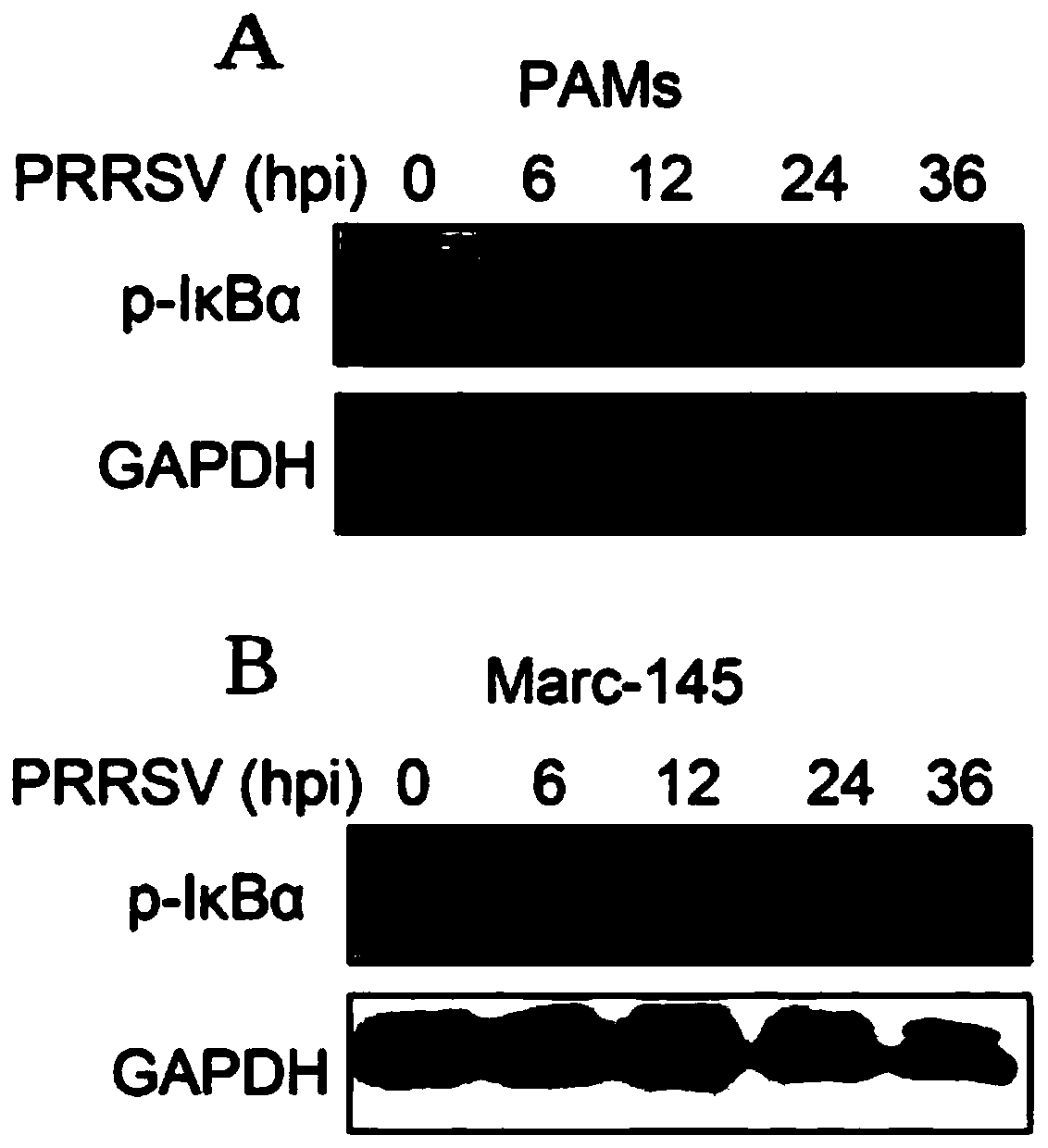Application of hpse gene in screening pigs resistant to PRRS
A technology for PRRSV and PRRSV, which is applied in the field of biomedicine, can solve the problems of PRRSV prevention and control, the lack of cross-protection of vaccines, and damage to the immune system of the body, and achieve good clinical application value.
- Summary
- Abstract
- Description
- Claims
- Application Information
AI Technical Summary
Problems solved by technology
Method used
Image
Examples
Embodiment 1
[0040] Example 1 PRRSV infection inhibits the expression of heparan sulfate HS
[0041] 1. Cultivate Marc-145 cells with DMEM medium containing 10% fetal bovine serum to a confluence of 60-70%, wash once with PBS, replace with DMEM medium containing 2% fetal bovine serum, and set MOI=0.1 Add PRRSV at 37°C, 5% CO 2 Cultured in a humidified incubator for 0, 24, and 36 h. Wash 3 times with PBS, fix with 4% paraformaldehyde for 10 min, wash with PBS for 10 min, perforate with 10% Triton-100 for 15 min, wash with PBS for 10 min, then block with 1% BSA diluted in PBS for 30 min, add anti-HSPG2 protein for one Anti-mouse (diluted 1:200) was incubated overnight at 4°C, anti-mouse secondary antibody (diluted 1:1000) was used for 1 h, nuclei were stained with DAPI dye for 5 min, and washed with PBS for 10 min. First check whether the heparan sulfate HS is stained under an ordinary fluorescent inverted microscope, and then observe under a confocal microscope.
[0042] 2. The result is...
Embodiment 2
[0043] Example 2 PRRSV infection activates NF-κB signaling pathway
[0044] 1. Culture Marc-145 and PAMs cells with DMEM and RPMI 1640 medium containing 10% fetal bovine serum respectively to a confluence of 60-70%, wash once with PBS, and replace with DMEM and RPMI 1640 containing 2% fetal bovine serum Culture medium, and add PRRSV at a ratio of MOI=0.1 at 37°C, 5% CO 2 Cultured in a humidified incubator for 0, 6, 12, 24, and 36 h. The p65 subunit of the NF-κB signaling pathway was detected by confocal and qRT-PCR according to the above method, and the cells were collected for Western Blot detection of the IκBα subunit of the NF-κB signaling pathway.
[0045] 2. The result is as follows figure 2 with 3 As shown, after PRRSV infects PAMs cells, the p65 subunit of NF-κB signaling pathway enters the nucleus ( figure 2 A), increasing the expression of p65 subunit of NF-κB signaling pathway ( figure 2 B). After PRRSV infected PAMs and Marc-145 cells, the phosphorylation of...
Embodiment 3
[0047] Example 3 PRRSV infection promotes HPSE gene expression
[0048] 1. Culture Marc-145 and PAMs cells with DMEM and RPMI 1640 medium containing 10% fetal bovine serum respectively to a confluence of 60-70%, wash once with PBS, and replace with DMEM and RPMI 1640 containing 2% fetal bovine serum Culture medium, and add PRRSV at a ratio of MOI=0.1 at 37°C, 5% CO 2 Cultured in a humidified incubator for 0, 6, 12, 24, and 36 h. Cells were collected for Western Blot detection of heparanase encoded by HPSE gene.
[0049] 2. The result is as follows Figure 4 As shown, PRRSV infects PAMs ( Figure 4 A) and Marc-145 ( Figure 4 B) after cells, the expression level of heparanase Heparanase encoded by HPSE gene is gradually increased. That is, PRRSV promotes the expression of HPSE gene after infecting PAMs and Marc-145 cells.
[0050] The expression of HPSE gene increased, and the activity of heparanase increased, which in turn cut HS, inhibited PRRSV particles from adhering ...
PUM
 Login to View More
Login to View More Abstract
Description
Claims
Application Information
 Login to View More
Login to View More - R&D
- Intellectual Property
- Life Sciences
- Materials
- Tech Scout
- Unparalleled Data Quality
- Higher Quality Content
- 60% Fewer Hallucinations
Browse by: Latest US Patents, China's latest patents, Technical Efficacy Thesaurus, Application Domain, Technology Topic, Popular Technical Reports.
© 2025 PatSnap. All rights reserved.Legal|Privacy policy|Modern Slavery Act Transparency Statement|Sitemap|About US| Contact US: help@patsnap.com



